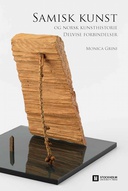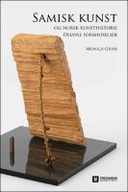Explore

Hvordan er samisk kunst fremstilt i norsk kunsthistorie? Så enkelt og så komplekst er spørsmålet som driver denne boken frem. Utgangspunktet er en nysgjerrighet omkring hvordan samisk transnasjonalstatelighet slår ut i kunsthistorien; et spørsmål som ikke tidligere har blitt fremhevet som eksplisitt innfallsvinkel i undersøkelser av samisk kunst.
Tilnærmingen hviler på en antagelse om at et underliggende nasjonalt paradigme fortsetter å gjøre seg gjeldene gjennom implisitte og naturaliserte prosesser, både i kunsthistorien og i andre institusjonaliserte rammeverk. Hvilke konsekvenser har dette hatt for behandlingen av samiske forbindelser som går på tvers av nasjonale statsgrenser?
Begrepet “norsk kunst” virker å være vokst frem parallelt med nasjonsbygging og etableringen av et kunsthistoriefag i Norge. Hvilken plass fikk samiske emner, praksiser, gjenstander og aktører i denne begreps- og institusjonsbyggingen? Hvordan bidro kunsthistoriefaget i skapelsen av “samisk kunst”, slik formasjonen etter hvert materialiserte seg institusjonelt og diskursivt? Slike spørsmål er beveggrunn for undersøkelsen.
At boken ender i det globale, også når nasjonale perspektiv undersøkes, er illustrerende for samiske forholds ambivalente plass i norsk kunsthistorie: Samisk kunst beveger seg stadig i andre kretsløp enn mye av den øvrige kunsten som behandles i denne historien.
Dette er en av svært få historiografiske analyser av kunsthistoriefaget i Norge, og den eneste med samisk historiografi som omdreiningspunkt.
***
Sápmi, the Sámi area, is transnational; it transcends four nation states, Norway, Sweden, Finland, and Russia. Art and art history has been considered natural parts of a nation state’s inventory at least since the 19th century and has contributed to the production and maintenance of national identities and narratives. What is the role of the nation state in art history, and how has the national paradigm affected the presentation of Sámi art, historically and today? Focusing on the discipline of art history in Norway, the volume exposes the prevailing representation of Sámi art, duodji, and dáidda as ethnographic material and relates it to the politics of nation building in the nineteenth and early twentieth century.
The book examines the representation of Sámi art, artefacts, practices, materialites, actors, concepts, and themes in Norwegian Art History, to uncover some of the established disciplinary mechanisms and narratives. The central method is historiography in combination with fieldwork in archives and museums, aimed at doing art historiography in the expanded field – to move beyond the traditional textual focus and question naturalized institutional and disciplinary boundaries.
This is one of very few historiographical studies of the art historical discipline in Norway, and the only one that does this by centring on Sámi traditions, items, actors, and conceptualizations.
This book is included in DOAB.
Why read this book? Have your say.
You must be logged in to comment.
Links
DOI: 10.16993/bbmweb: http://www.stockholmuniversitypress.se/site/books/m/10.16993/bbm/
Editions





